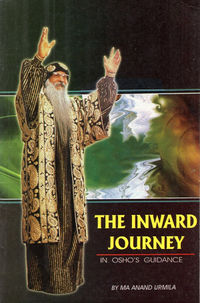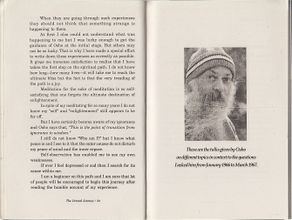The Inward Journey: Difference between revisions
Jump to navigation
Jump to search
(Add info.) |
mNo edit summary |
||
| Line 3: | Line 3: | ||
| | | | ||
translated = Hindi [[Shanti Ki Khoj (शांति की खोज)]] | | translated = Hindi [[Shanti Ki Khoj (शांति की खोज)]] | | ||
notes = | notes =[[{{PAGENAME}}#preface|Preface below]], with the story of how this book was written by [[Ma Anand Urmila]] under Osho's guidance. | | ||
period = Jan, 1966 to Mar, 1967|year=1966| | period = Jan, 1966 to Mar, 1967|year=1966| | ||
nofd =15 (15th is a later addition about Osho) | | nofd =15 (15th is a later addition about Osho) ([[{{PAGENAME}}#table of contents|table of contents below]])| | ||
editions = | editions = | ||
{{bookedition|3090_sml.jpg|In Osho's Guidance|2005|Diamond Books|1|81-288-0989-X |111|P|Edition: 2005. © Publisher. | {{bookedition|3090_sml.jpg|In Osho's Guidance|2005|Diamond Books|1|81-288-0989-X |111|P|Edition: 2005. © Publisher. | ||
Revision as of 10:33, 29 March 2016
- An English translation of the Hindi original Shanti Ki Khoj, this book is a collection of 14 short discourses of Osho, the central theme of which is that the inward journey to ourself or to our source is not difficult but it seems difficult because we are no longer simple, there is contradiction in our heart and actions.
- translated from
- Hindi Shanti Ki Khoj (शांति की खोज)
- notes
- Preface below, with the story of how this book was written by Ma Anand Urmila under Osho's guidance.
- time period of Osho's original talks/writings
- Jan, 1966 to Mar, 1967 : timeline
- number of discourses/chapters
- 15 (15th is a later addition about Osho) (table of contents below)
editions
The Inward JourneyIn Osho's Guidance
Pages 34 - 35. |
table of contents
- Preface … 7
- Introduction … 9
- Chapter 1. The Master Appears When The Disciple Is Ready … 37
- Chapter 2. Why The Master Seeks The Disciples? … 41
- Chapter 3. Ask Only Existential Questions … 45
- Chapter 4. God Is Not The Creator But The Creativity … 51
- Chapter 5. The Theory Of Incarnation Of God … 55
- Chapter 6. What Is Religion? … 59
- Chapter 7. Meditation Changes the Taste Of Food … 63
- Chapter 8. Love … 73
- Chapter 9. Egotism And Self-Respect … 80
- Chapter 10. Motherhood … 85
- Chapter 11. A Boxing Match … 89
- Chapter 12. Art … 91
- Chapter 13. Ordinary Artist, Genius And Yogi … 97
- Chapter 14. Satyam Shivam Sundaram - The Truth, The Good, The Beautiful … 101
- Chapter 15. Osho … 107
preface
- Preface
- This is the English version of the Hindi book, 'Shanti ki Khoj' published in 1970 by Jeevan Jagruti Kendra, Bombay as instructed by Osho. This book is a compilation of Osho's talks which were actually the answers to Ma Anand Urmila's questions asked by her during her stay in Jabalpur, from January 1966 to March 1967.
- At that time Osho was teaching philosophy in Mahakoshal College, Jabalpur and he was known as "Acharya Rajneesh". The name written on his name-plate at his residence, Yogesh Bhawan, and also on his letterhead was Acharya Rajneesh.
- He used to drop in at Ma Urmila's place while going to his college or returning from there. During these visits he expressed his views on various topics regarding spiritual path and life in general.
- This is an authentic reporting of his discussions with her, because he had asked her to write down whatever he had said and this she did regularly.
- Everyday after his departure she used to write down the whole matter and read it out to him the next day to get his approval.
- After listening to the written material, invariably he said 'Okay' .
- After some time Osho asked her to write her own experience of meditation so that it would be the introduction to the compilation of his talks (the answers to her questions) which would be published in her name.
- This idea was a surprise to her and she protested vehemently because she thought that being a novice on the path of meditation she had nothing much to say and her contribution to the book was nothing except noting down his words of wisdom.
- Then Osho explained to her that by publishing her experience of meditation he wanted to convince the people in general that everyone can tread the path of meditation and no special quality or qualification is required for this.
- After listening to this argument of Osho, she had to agree to the idea of the book being published in her name.
- Even the title of the book was decided by Osho.


